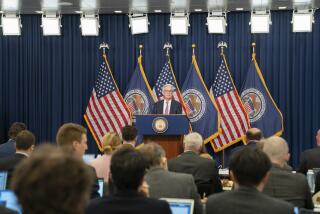Brady Asks Action on S&L; ‘Hemorrhaging’
- Share via
WASHINGTON — Treasury Secretary Nicholas F. Brady delivered President Bush’s plan for cleaning up the savings and loan industry to Congress today and asked that it be swiftly approved.
Noting the President’s Feb. 9 challenge to Congress to pass the funding and reform package in 45 days, Brady said, “Once Congress acts, we will be ready to move to stem the hemorrhaging” by closing insolvent S&Ls; that pay high interest rates to attract depositors.
“Fast action . . . will help reduce the industry’s cost of funds by getting the insolvent institutions resolved, out of the marketplace and out of the business of needlessly bidding up the cost of funds,” Brady said in testimony before the Senate Banking Committee. “ . . . The time to act is now.”
Bush’s plan calls for spending $126 billion through 1999 to shut down about 350 insolvent institutions and meet commitments from last year’s rescue of 205 others.
The President also wants changes in the regulatory structure, including one strongly opposed by the S&L; industry: placing the S&L; regulatory agency, the Federal Home Loan Bank Board, in the Treasury Department.
Brady told the committee, “We do not intend to micromanage the revitalized Federal Home Loan Bank System.” But, he added, “Treasury oversight is essential to ensure that these problems do not occur again.”
The Treasury secretary also outlined two new refinements of the plan.
S&L; owners are being required to put up more of their own money, or capital, but Brady said they would have 10 years to take “good will” off their books. Good will is the value an institution has as a going concern, but many analysts say it should not be included in capital because it disappears once an institution is liquidated.
Brady also said the maximum insurance premium for banks and S&Ls; would be $3.50 per $1,000 in deposits. The Administration previously said the maximum would be $7.50. Currently, banks pay 83 cents and S&Ls;, $2.08.
Brady’s testimony, the first hearing on the plan since Bush proposed it two weeks ago, came amid criticism that it provides too little money and is based on rosy economic projections.
More to Read
Get the L.A. Times Politics newsletter
Deeply reported insights into legislation, politics and policy from Sacramento, Washington and beyond. In your inbox twice per week.
You may occasionally receive promotional content from the Los Angeles Times.










